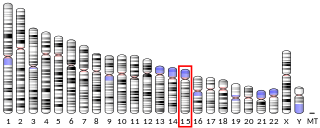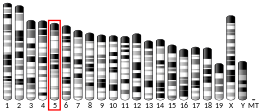
TSBP1 is a protein that in humans is encoded by the TSBP1 gene. C6orf10 is an open reading frame on chromosome 6 containing a protein that is ubiquitously expressed at low levels in the adult genome and may play a role during fetal development. C6orf10 has been found to be linked to both neurodegenerative and autoimmune diseases in adults. Expression of this gene is highest in the testis but is also seen in other tissue types such as the brain, lens of the eye and the medulla. TSBP1 was previously known as C6orf10.

Interferon-inducible GTPase 5 also known as immunity-related GTPase cinema 1 (IRGC1) is an enzyme that in humans is coded by the IRGC gene. It is predicted to behave like other proteins in the p47-GTPase-like and IRG families. It is most expressed in the testis.
C5orf34 is a protein that in humans is encoded by the C5orf34 gene (5p12).

Glutamate Rich Protein 2 is a protein in humans encoded by the gene ERICH2. This protein is expressed heavily in male tissues specifically in the testes, and proteins are specifically found in the nucleoli fibrillar center and the vesicles of these testicular cells. The protein has multiple protein interactions which indicate that it may play a role in histone modification and proper histone functioning.

Chromosome 9 open reading frame 25 (C9orf25) is a domain that encodes the FAM219A gene. The terms FAM219A and C9orf25 are aliases and can be used interchangeably. The function of this gene is not yet completely understood.

Testis-expressed protein 9 is a protein that in humans is encoded the TEX9 gene. TEX9 that encodes a 391-long amino acid protein containing two coiled-coil regions. The gene is conserved in many species and encodes orthologous proteins in eukarya, archaea, and one species of bacteria. The function of TEX9 is not yet fully understood, but it is suggested to have ATP-binding capabilities.
Chromosome 1 open reading frame (C1orf167) is a protein which in humans is encoded by the C1orf167 gene. The NCBI accession number is NP_001010881. The protein is 1468 amino acids in length with a molecular weight of 162.42 kDa. The mRNA sequence was found to be 4689 base pairs in length.

Transmembrane protein 155 is a protein that in humans is encoded by the TMEM155 gene. It is located on human chromosome 4, spanning 6,497 bases. It is also referred to as FLJ30834 and LOC132332. This protein is known to be expressed mainly in the brain, placenta, and lymph nodes and is conserved throughout most placental mammals. The function and structure of this protein is still not well understood, but its level of expression has been studied pertaining to various pathologies.

C5orf46 is a protein coding gene located on chromosome 5 in humans. It is also known as sssp1, or skin and saliva secreted protein 1. There are two known isoforms known in humans, with isoform 2 being the longer of the two. The protein encoded is predicted to have one transmembrane domain, and has a predicted molecular weight of 9,692 Da, and a basal isoelectric point of 4.67.

C16orf90 or chromosome 16 open reading frame 90 produces uncharacterized protein C16orf90 in homo sapiens. C16orf90's protein has four predicted alpha-helix domains and is mildly expressed in the testes and lowly expressed throughout the body. While the function of C16orf90 is not yet well understood by the scientific community, it has suspected involvement in the biological stress response and apoptosis based on expression data from microarrays and post-translational modification data.

Uncharacterized protein C17orf78 is a protein encoded by the C17orf78 gene in humans. The name denotes the location of the parent gene, being at the 78th open reading frame, on the 17th human chromosome. The protein is highly expressed in the small intestine, especially the duodenum. The function of C17orf78 is not well defined.

Chromosome 1 Opening Reading Frame 94 or C1orf94 is a protein in human coded by the C1orf94 gene. The function of this protein is still poorly understood.

ProteinFAM89A is a protein which in humans is encoded by the FAM89A gene. It is also known as chromosome 1 open reading frame 153 (C1orf153). Highest FAM89A gene expression is observed in the placenta and adipose tissue. Though its function is largely unknown, FAM89A is found to be differentially expressed in response to interleukin exposure, and it is implicated in immune responses pathways and various pathologies such as atherosclerosis and glioma cell expression.

Leucine rich single-pass membrane protein 2 is a single-pass membrane protein rich in leucine, that in humans is encoded by the LSMEM2 gene. The LSMEM2 protein is conserved in mammals, birds, and reptiles. In humans, LSMEM2 is found to be highly expressed in the heart, skeletal muscle and tongue.
TMEM275 is a protein that in humans is encoded by the TMEM275 gene. TMEM275 has two, highly-conserved, helical trans-membrane regions. It is predicted to reside within the plasma membrane or the endoplasmic reticulum's membrane.

The FAM214B, also known as protein family with sequence similarity 214, B (FAM214B) is a protein that, in humans, is encoded by the FAM214B gene located on the human chromosome 9. The protein has 538 amino acids. The gene contain 9 exon. There has been studies that there are low expression of this gene in patients with major depression disorder. In most organisms such as mammals, amphibians, reptiles, and birds, there are high levels of gene expression in the bone marrow and blood. For humans in fetal development, FAM214B is mostly expressed in the brains and bone marrow.

Family with Sequence Similarity 166, member C (FAM166C), is a protein encoded by the FAM166C gene. The protein FAM166C is localized in the nucleus. It has a calculated molecular weight of 23.29 kDa. It also contains DUF2475, a protein of unknown function from amino acid 19–85. The FAM166C protein is nominally expressed in the testis, stomach, and thyroid.

C11orf98 is a protein-encoding gene on chromosome 11 in humans of unknown function. It is otherwise known as c11orf48. The gene spans the chromosomal locus from 62,662,817-62,665,210. There are 4 exons. It spans across 2,394 base pairs of DNA and produces an mRNA that is 646 base pairs long.

C4orf19 is a protein which in humans is encoded by the C4orf19 gene.

Zinc Finger Protein 62, also known as "ZNF62," "ZNF755," or "ZET," is a protein that in humans is encoded by the ZFP62 gene. ZFP62 is part of the C2H2 Zinc Finger family of genes.



















